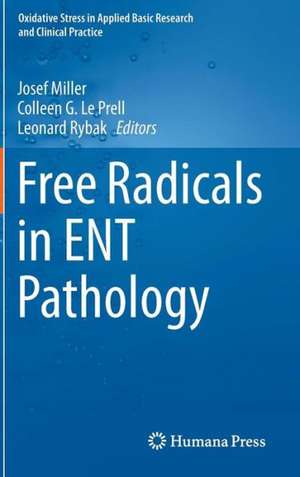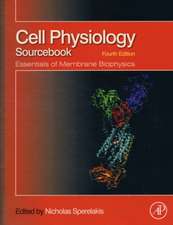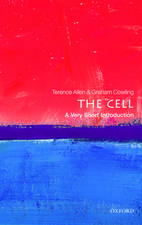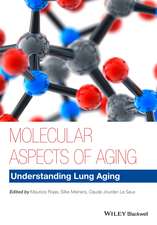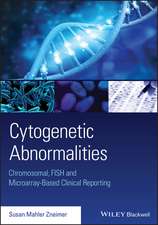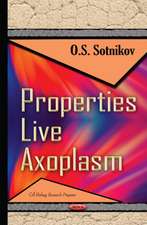Free Radicals in ENT Pathology: Oxidative Stress in Applied Basic Research and Clinical Practice
Editat de Josef Miller, Colleen G. Le Prell, Leonard Rybaken Limba Engleză Hardback – 13 mai 2015
Din seria Oxidative Stress in Applied Basic Research and Clinical Practice
- 5%
 Preț: 1483.21 lei
Preț: 1483.21 lei - 18%
 Preț: 1272.98 lei
Preț: 1272.98 lei - 18%
 Preț: 1007.65 lei
Preț: 1007.65 lei - 18%
 Preț: 1843.73 lei
Preț: 1843.73 lei - 18%
 Preț: 1667.12 lei
Preț: 1667.12 lei - 18%
 Preț: 1242.52 lei
Preț: 1242.52 lei - 15%
 Preț: 695.70 lei
Preț: 695.70 lei - 15%
 Preț: 700.94 lei
Preț: 700.94 lei - 18%
 Preț: 1235.43 lei
Preț: 1235.43 lei - 18%
 Preț: 1560.73 lei
Preț: 1560.73 lei - 18%
 Preț: 1225.94 lei
Preț: 1225.94 lei - 18%
 Preț: 951.29 lei
Preț: 951.29 lei - 18%
 Preț: 959.98 lei
Preț: 959.98 lei - 18%
 Preț: 953.65 lei
Preț: 953.65 lei - 18%
 Preț: 965.97 lei
Preț: 965.97 lei - 18%
 Preț: 966.27 lei
Preț: 966.27 lei - 18%
 Preț: 958.07 lei
Preț: 958.07 lei - 15%
 Preț: 654.95 lei
Preț: 654.95 lei - 18%
 Preț: 954.45 lei
Preț: 954.45 lei - 18%
 Preț: 962.18 lei
Preț: 962.18 lei - 24%
 Preț: 826.78 lei
Preț: 826.78 lei - 20%
 Preț: 562.86 lei
Preț: 562.86 lei - 18%
 Preț: 1243.46 lei
Preț: 1243.46 lei - 18%
 Preț: 1010.96 lei
Preț: 1010.96 lei
Preț: 961.41 lei
Preț vechi: 1172.45 lei
-18% Nou
Puncte Express: 1442
Preț estimativ în valută:
183.99€ • 191.38$ • 151.89£
183.99€ • 191.38$ • 151.89£
Carte tipărită la comandă
Livrare economică 14-28 aprilie
Preluare comenzi: 021 569.72.76
Specificații
ISBN-13: 9783319134727
ISBN-10: 3319134728
Pagini: 846
Ilustrații: XIV, 507 p. 43 illus., 32 illus. in color.
Dimensiuni: 155 x 235 x 28 mm
Greutate: 0.9 kg
Ediția:2015
Editura: Springer International Publishing
Colecția Humana
Seria Oxidative Stress in Applied Basic Research and Clinical Practice
Locul publicării:Cham, Switzerland
ISBN-10: 3319134728
Pagini: 846
Ilustrații: XIV, 507 p. 43 illus., 32 illus. in color.
Dimensiuni: 155 x 235 x 28 mm
Greutate: 0.9 kg
Ediția:2015
Editura: Springer International Publishing
Colecția Humana
Seria Oxidative Stress in Applied Basic Research and Clinical Practice
Locul publicării:Cham, Switzerland
Public țintă
ResearchCuprins
1. Introduction.- Section 1: Basic Science of Free Radical Biology in ENT.- 2. Free radicals and oxidative stress: Basic concepts and misconceptions.- 3. A Question of Balance: Free Radicals and Cochlear Homeostasis.- 4. Antioxidants and their effect on stress-induced pathology in the inner ear.- Section 2: Epidemiology of Hearing Loss.- 5. Role of free radicals in hearing loss due to heavy metals.- 6. The role of nutrition in healthy hearing: human evidence.- Section 3: Oxidative Stress and Noise-Induced Hearing Loss.- 7. Basic mechanisms underlying noise-induced hearing loss.- 8. Oxidative stress in noise-induced hearing loss.- 9. Strategies for evaluating antioxidant efficacy in clinical trials assessing prevention of noise-induced hearing loss.- Section 4: Oxidative Stress and Drug-Induced Hearing Loss.- 10. Aminoglycoside-induced oxidative stress: pathways and protection.- 11. Hearing loss after cis-platin: oxidative stress pathways and potential for protection.- 12. Assessment of interventions to prevent drug-induced hearing loss (DIHL).- Section 5: Oxidative Stress and Age-Related Hearing Loss.- 13. Age-related hearing loss: biochemical pathways and molecular targets.- 14. Genetics and age-related hearing loss.- 15. Mechanisms of age-related hearing loss.- 16. Interventions to prevent age-related hearing loss.- Section 6. Hereditary Hearing Loss.- 17. Genes and hearing loss: relationship to oxidative stress and free radical formation.- 18. Strategies for the treatment of hereditary hearing loss.- Section 7: Cochlear Implants, Radiation, Trauma and Other Stress Factors.- 19. Loss of Residual Hearing Initiated by Cochlear Implantation: Role of Inflammation-Initiated Cell.- 20. Role of oxidative stress in sudden hearing loss and Meniere’s disease.- Section 8: Head and Neck.- 21. Role of free radicals in head and neck pathology .- 22. Free radicals and sleep apnea.- 23. Free radicals in nasal and paranasal disease.- 24. Conclusion.
Notă biografică
Dr. Josef M. Miller is the Lynn and Ruth Townsend Professor of Communication Disorders at the University of Michigan and an Adjunct Professor at the Karolinska Institutet, Sweden. He has worked in the area of hearing sciences for more than 30 years. His major area of research interest is in the neuroscience of the auditory system, including studies on the cochlear prosthesis, blood flow to the inner ear, prevention of noise-induced deafness, and prevention of degeneration and promotion of regrowth of the auditory nerve. He has led major research teams under the National Institutes of Health (NIH) Program Project support and for all of his career has held RO-1 funding for research on studies of the inner ear and CNS. Dr. Miller is responsible for developing research laboratories and major collaborative research programs between the USA and Europe on studies of tissue engineering of the inner ear and training programs for graduate students and medical residents.
Dr. Colleen Le Prell is an Associate Professor in the Department of Speech, Language, and Hearing Sciences at the University of Florida. She received her doctorate in Psychology (Biospsychology area) from the University of Michigan followed by post-doctoral studies at the Kresge Hearing Research Institute. Her post-doctoral research emphasized the pharmacology of the inner ear, and was funded by a National Research Service Award from the National Institutes of Health. Current research programs in her laboratory at the University of Florida continue her long-term efforts to precisely characterize the influence of the lateral olivocochlear neurons on auditory nerve function, and extend a collaborative translational research program directed at prevention of acquired hearing loss, including hearing loss induced by exposure to loud sound. She has presented her research findings nationally and internationally, and has lectured on the challenges of translational research inOtolaryngology including a short course lecture to the Association for Research in Otolaryngology.
Dr. Leonard P. Rybak is a Professor in the Department of Surgery at Southern Illinois University School of Medicine. He received his medical degree from the Medical College of Wisconsin-Milwaukee and completed his internship at Hennepin County Medical Center in Minneapolis. He completed a residency in otolaryngology and also obtained a Ph.D. at the University of Minnesota-Minneapolis. Prior to coming to the SIU School of Medicine, he was an Assistant Professor of Otolaryngology at the University of Minnesota. Dr. Rybak’s research interests include growth of cochlear hair cells derived from Immortomouse (HEI-OC1, OC-k3 cells) in culture and mechanisms controlling free radical production within the cochlea.
Dr. Colleen Le Prell is an Associate Professor in the Department of Speech, Language, and Hearing Sciences at the University of Florida. She received her doctorate in Psychology (Biospsychology area) from the University of Michigan followed by post-doctoral studies at the Kresge Hearing Research Institute. Her post-doctoral research emphasized the pharmacology of the inner ear, and was funded by a National Research Service Award from the National Institutes of Health. Current research programs in her laboratory at the University of Florida continue her long-term efforts to precisely characterize the influence of the lateral olivocochlear neurons on auditory nerve function, and extend a collaborative translational research program directed at prevention of acquired hearing loss, including hearing loss induced by exposure to loud sound. She has presented her research findings nationally and internationally, and has lectured on the challenges of translational research inOtolaryngology including a short course lecture to the Association for Research in Otolaryngology.
Dr. Leonard P. Rybak is a Professor in the Department of Surgery at Southern Illinois University School of Medicine. He received his medical degree from the Medical College of Wisconsin-Milwaukee and completed his internship at Hennepin County Medical Center in Minneapolis. He completed a residency in otolaryngology and also obtained a Ph.D. at the University of Minnesota-Minneapolis. Prior to coming to the SIU School of Medicine, he was an Assistant Professor of Otolaryngology at the University of Minnesota. Dr. Rybak’s research interests include growth of cochlear hair cells derived from Immortomouse (HEI-OC1, OC-k3 cells) in culture and mechanisms controlling free radical production within the cochlea.
Textul de pe ultima copertă
This comprehensive volume examines the current state of free radical biology and its impact on otology, laryngology, and head and neck function. The chapters collectively highlight the interrelationship of basic and translational studies in each area, define the challenges to translation, and identify the existing basic issues that demand investigation as well as the opportunities for novel intervention to prevent and treat ENT pathology and impairment. In each chapter, or in some cases pairs of chapters, the author(s) have included or married issues of basic research with translational challenges and research, thus defining the pathway by which new basic insights may lead to interventions to prevent or treat impairment. The final chapter of this book reflects a meeting of all the contributors, culminating in a discussion and “white paper” that identifies the challenges to the field and defines the studies and collaborations that may lead to improved understanding of free radical biology in ENT and, subsequently, new interventions to medically treat ENT pathology.
Caracteristici
Assembles comprehensive reviews on a broad variety of ENT pathology, including areas partially covered in current literature, such as the role of nutrition and heavy metals in hearing, Discusses the interrelationship of basic and translational studies Uniquely outlines a path for future research and development of antioxidant interventions?
